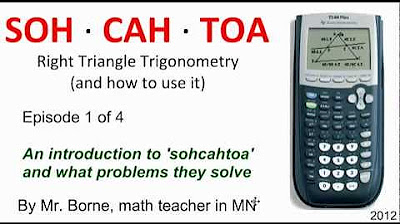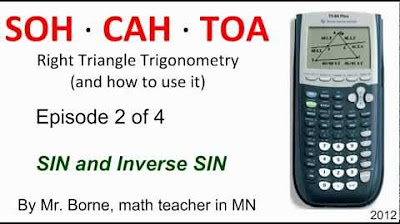Physics 20: 2.2 Vector Components
Summary
TLDRThe video tutorial covers the basics of vectors, focusing on how to draw and solve them using right-angle triangle math. It provides step-by-step examples to demonstrate calculating the resultant vector and angle using Pythagorean theorem and trigonometric functions. The instructor emphasizes careful diagram drawing and explains the importance of maintaining significant figures. The lesson also covers reverse calculations to find vector components and includes various methods to express the final answers in vector form.
Takeaways
- 📏 Vectors can be represented and solved using basic right-angle triangle math.
- 🚗 Example 1: A car traveling east at 15 m/s and south at 11 m/s requires finding the resultant vector.
- 🔍 Resultant vectors are found by drawing a right-angle triangle and calculating the hypotenuse and angles.
- 📐 Use Pythagorean theorem to find the resultant magnitude: \(√(15^2 + 11^2) = 18.6\) m/s.
- 🔢 Calculate the angle using trigonometric functions: \(tan^{-1}(11/15) = 36.3°\).
- 🧭 Direction can be expressed in terms of cardinal directions or degrees: 36.3° south of east or 324°.
- ✈️ Example 2: An airplane heading north at 32 m/s with an east wind of 12 m/s requires similar steps to find the resultant vector.
- 📊 Apply Pythagorean theorem and trigonometric functions for second example: 34 m/s at 21° east of north.
- ↩️ Reverse process: Decomposing a vector into its horizontal and vertical components using sine and cosine functions.
- ⚖️ Example 3: A vector of 16 m at 27° east of north is decomposed into 7.26 m east and 14.3 m north.
- 🚀 Consistency in angles and components is key for accurate vector analysis and representation.
Q & A
What is the main topic discussed in the video script?
-The main topic discussed in the video script is how to properly draw and calculate vectors, specifically focusing on velocity vectors and their components.
Why is it important to be careful with diagrams when dealing with vectors?
-It is important to be careful with diagrams because they help visualize the direction and magnitude of vectors, which are crucial for accurately performing mathematical operations and solving vector problems.
What is the first example given in the script involving vectors?
-The first example given in the script involves a car traveling with a uniform motion where the East component of the motion is 15 meters per second and the South component is 11 meters per second.
How is the resultant velocity vector calculated in the car example?
-The resultant velocity vector is calculated using the Pythagorean theorem, by adding the squares of the East and South components, and then taking the square root of the sum to find the magnitude of the resultant vector.
What mathematical operation is used to find the magnitude of the resultant vector?
-The Pythagorean theorem is used to find the magnitude of the resultant vector by calculating the square root of the sum of the squares of its components.
How many significant digits should be kept in the final answer according to the car example in the script?
-The final answer should be kept to three significant digits, as per the given values in the car example (15.0 and 11.0).
What trigonometric function is used to find the angle when you have the opposite and adjacent sides of a right triangle?
-The tangent function (tan) is used to find the angle when you have the opposite and adjacent sides of a right triangle.
How is the angle of the resultant vector found in the car example?
-The angle of the resultant vector is found by using the tangent function with the South component (opposite side) over the East component (adjacent side), and then using the inverse tangent function (second ten on a calculator) to find the angle in degrees.
What is the process for finding the components of a vector when given its magnitude and direction?
-The process involves using trigonometric functions sine and cosine to find the horizontal (east/west) and vertical (north/south) components of the vector, respectively.
How are the components of a vector expressed in terms of direction?
-The components of a vector are expressed in terms of direction by stating the magnitude followed by the direction, such as 'North' or 'East', or by giving the angle from the horizontal or vertical axis.
What is the significance of the wind direction mentioned in the airplane example?
-The wind direction is significant because it affects the airplane's resultant velocity. A wind blowing from the West (Westerly wind) means it is blowing towards the East, which is an important factor when calculating the airplane's actual velocity.
How is the resultant velocity of the airplane calculated in the script?
-The resultant velocity of the airplane is calculated using the Pythagorean theorem with the northward velocity and the eastward wind velocity as components, and then finding the angle using the tangent function.
What are the two components of a vector and why are they important?
-The two components of a vector are its horizontal (east/west) and vertical (north/south) parts. They are important because they allow for the analysis of a vector's effect in different directions, which is useful in various applications such as physics and engineering.
How does the script suggest finding the horizontal component of a vector?
-The script suggests finding the horizontal component of a vector by using the cosine of the given angle and the magnitude of the vector, calculated as the magnitude times the cosine of the angle.
How does the script suggest finding the vertical component of a vector?
-The script suggests finding the vertical component of a vector by using the sine of the given angle and the magnitude of the vector, calculated as the magnitude times the sine of the angle.
Outlines

Cette section est réservée aux utilisateurs payants. Améliorez votre compte pour accéder à cette section.
Améliorer maintenantMindmap

Cette section est réservée aux utilisateurs payants. Améliorez votre compte pour accéder à cette section.
Améliorer maintenantKeywords

Cette section est réservée aux utilisateurs payants. Améliorez votre compte pour accéder à cette section.
Améliorer maintenantHighlights

Cette section est réservée aux utilisateurs payants. Améliorez votre compte pour accéder à cette section.
Améliorer maintenantTranscripts

Cette section est réservée aux utilisateurs payants. Améliorez votre compte pour accéder à cette section.
Améliorer maintenantVoir Plus de Vidéos Connexes
5.0 / 5 (0 votes)






